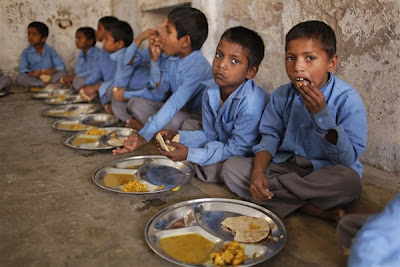
The Food for Thought report by Save the Children found that undernourished children were an average of 20 percent less literate than those who had a “nutritious diet.”
It said that that malnutrition could affect global economic growth by $125 billion.
"A quarter of the world's children are suffering the effects of chronic malnutrition. Poor nutrition in the early years is driving a literacy and numeracy crisis in developing countries and is also a huge barrier to further progress in tackling child deaths," Carolyn Miles, president and chief executive of Save the Children, said in a statement.
"Improving the nutritional status of children and women in the crucial 1,000-day window – from the start of a woman's pregnancy until her child's second birthday – could greatly increase a children's ability to learn and to earn," she added.
She urged world leaders to “commit to concrete actions to tackle malnutrition in those critical 1,000 days, and invest in the future of our children.”
The report found that malnourished children: scored 7 percent lower in math tests and were 19 percent less likely to be able to read at the age of 8; were 13 percent less likely to be in the appropriate school grade for their age; were likely to earn at least 20 percent as adults.
It said that extrapolating a 20-percent reduction in earnings to a global level would mean childhood malnutrition could potentially cost the global economy some $125 billion in 2030.
The report was based on studies of thousands of children in Ethiopia, India, Peru and Vietnam.
It found that at the age of 8, children who were stunted because of chronic malnutrition were 19 percent more likely to make a mistake when reading a simple sentence like "I like dogs" or "The sun is hot" than expected for a child of that age.
The report noted there had been “huge progress” in helping children over the last two decades.
Between 1990 and 2011, the number of children who died before the age of 5 fell from 12 million to 6.9 million – “faster than ever before.”
And since 1999, the number of kids in elementary school had gone up by more than 40 million.
“However, malnutrition threatens to undermine these impressive advances. In spite of the reduction in children dying, the global crisis of child mortality remains unsolved – 19,000 children continue to die each day from preventable causes,” the report said. “Meanwhile, a global crisis in education means 130 million children are in school but failing to learn even the basics.”
“They are left without the core skills and abilities they need to fulfil their potential and to lead fulfilling, productive lives.
“Child malnutrition is a key factor underlying both these crises. Malnutrition is an underlying cause of 2.3 million children’s deaths a year and, for millions more children, contributes to failures in cognitive and educational development. As a result, the life chances of millions of children around the world are devastated. The potential cost to the global economy runs to billions of dollars.”

